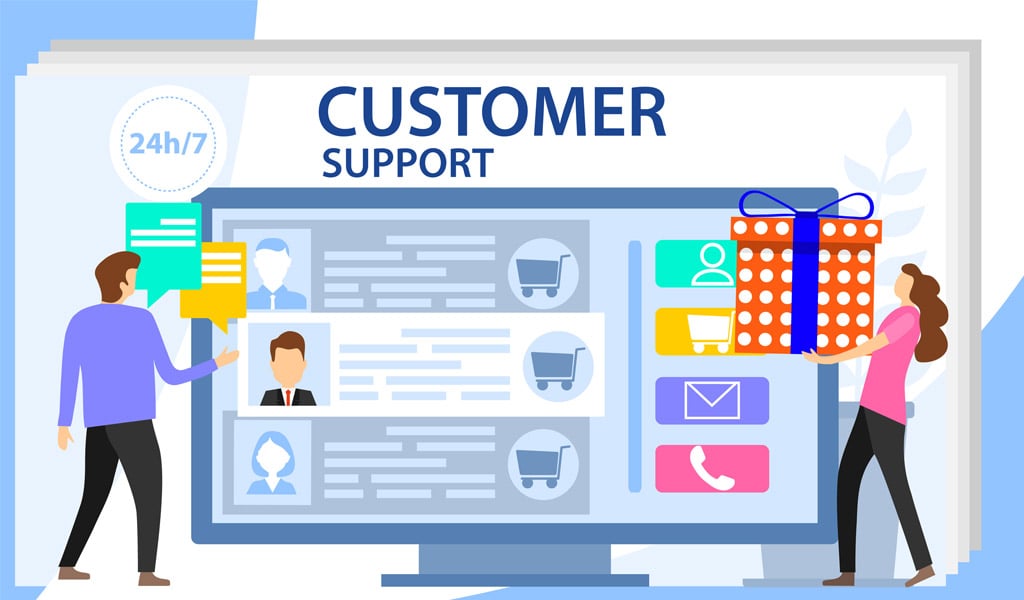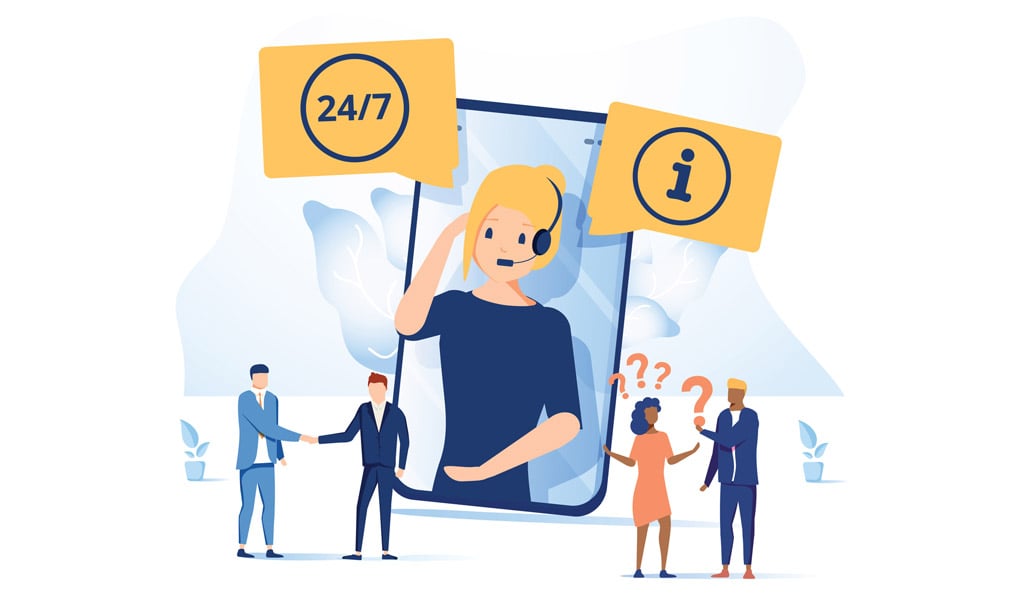
In a world where fierce competition is the new baseline state of being, businesses are forced to look for innovative new ways to stand out from their competitors. One such way is through customer support.
The Power of Customer Support in the Digital Age
Traditionally, customer support or customer service has just been a support function – no less and no more. It’s been a purely reactive function tasked with calming an onslaught of frustrated customers. The phone would ring, an agent would answer, and the cycle would repeat.
Today, the definition of customer support has shifted dramatically. It’s no longer acceptable to just react, instead, you have to be proactive. You have to consider how the customer feels as they move through every aspect of the customer journey and how each interaction will shape their opinion of your company.
Customer opinions don’t exist in a bubble, and especially not in the digital age. Going back 20 years, an upset or dissatisfied customer had much less power than they do today. They might have a negative experience and go home and rant to their family or neighbors, but their harsh words were limited to their social circle. They simply couldn’t impact the opinions of a wider group of people, and as a result, it was very difficult for one customer to impact the reputation of a company.
In the digital age, this has all changed. Today when a customer has a bad experience, they have the whole world at their fingertips. A post on social media can go viral while employees are asleep. Reviews on independent review sites have become a popular way for people to air their frustrations, and these review sites are widely utilized by prospective customers.
Something that is often missed by companies is that customers having more power is actually a great thing. Sometimes customers have bad experiences because companies offer bad experiences. They fail to understand their customers and address their needs. While it’s certainly true that customers in the past had less power, companies had less power too. When a customer had a bad experience, it was much more difficult for the company to capture the details of why this experience was bad. Without online reviews, omnichannel data and voice data, and advanced data analysis, common problems were guaranteed to be missed. Bad experiences were doomed to be repeated.
By contrast, with the expert tools we have available today, companies are empowered to understand their customers in a way that was never possible in the past. They can attract the right customers and deliver tailored experiences to these customers. Customers become happier, and revenues go up.
With this in mind, today we’re going to tell you how to turn your customer support function into a competitive advantage. Let’s take a look.

7 Tips to Get Started
1. Be Flexible
Over time, companies have become increasingly focused on creating scripts, rules, and guidelines for their customer service agents. It’s easy to see how this evolved. When agents make mistakes, companies want to make sure this doesn’t happen again by adding on a new guideline or rule that agents have to follow.
However, this approach can be severely limiting for several reasons. Having autonomy is a huge part of what makes something fulfilling. When companies limit what representatives do, several things happen:
- Agents don’t feel in control of their own work. They feel like a robot executing commands, and this isn’t rewarding.
- When they do something successfully, they don’t believe they deserve the credit for it. After all, it wasn’t their decision.
- Customers get a more limited experience. Sometimes the agent can solve the problem using a unique solution, but they aren’t allowed to do this. Both the customer and the agent miss out.
- It’s more difficult for agents to build a rapport with customers because communication is more rigid. When communication is more fluid, agents can adapt their communication style to meet the customer’s needs.
“Today’s consumers do not buy just products or services — more and more, their purchase decisions revolve around buying into an idea and an experience.” McKinsey
You can’t create a rigid rulebook for the perfect experience for every customer. Customers can differ greatly in their personalities, preferences, and desires. So instead of creating the perfect rulebook, be flexible and encourage the positive traits you want to see in your agents.
2. Perfect Friendliness
This may seem like an obvious one, but there’s just as much art as science when it comes to being friendly. Many companies focus on how to be polite, rather than friendly. It’s still important to be polite of course, but you shouldn’t confuse these two approaches. Here’s how we define the difference:
Politeness – At marked effort towards being inoffensive, meeting social expectations for communication (staying within norms), and being respectful considerate of customers.
Friendliness – Being warm, kind, caring, and putting the customer at ease.
Switching from just being polite to being actively friendly can help create a more memorable impression on customers. A study by American Express found that 68% of customers said a friendly representative was key to their recent positive experience. Here are some tips on improving friendliness:
- Smile with your voice – Your warmth can be heard in your voice so always make sure to display warmth. This is particularly important for the greeting.
- Be memorable with gratitude – Remember to thank customers as often as is appropriate. People feel good when they believe they are part of your success journey.
- Practice active listening.
3. Develop Your Company Voice
Developing a company voice helps create your own unique style and way of doing things. When you do this, and if you do it consistently, you will be more memorable to customers. When your company is more memorable, customers will automatically think of you when they need a similar product in the future.
Here are some tips for developing your company voice in the customer support function:
- If you had to pick 3-5 words that best describe your company and your goals, what would they be? Make sure that your agents are aware of these words. You can create cards to have on agent’s desks, screensavers, or something else. The key is to make sure these words are always at the forefront of your agent’s minds.
- Create a mission statement and ensure that agents are familiar with it. The key is to get agents to start thinking in the language and goals of your company.
- Purge content that doesn’t match your mission or voice. While this content may lay outside of the customer support function, for example, it may be in the form of articles on your website, it’s still crucial. Your agents are your first line of defense. Customers may read something on your website and start asking your agent’s questions about it. You make the agent’s job harder if the content you put out doesn’t match your voice.
- Ask yourself, if your company was a person, what would they sound like? How would they behave?
- Identify your strengths as a company and lead with these strengths when communicating with customers.

4. Utilize Technology to Personalize Experiences and Streamline Experiences
Like we discussed above, customers are a varied group, each with their own preferences. You can’t expect to meet the needs of all of your customers if you only offer things that only appeal to a select group of customers.
For example, if your customer support function can only be accessed by phone, then you’re already failing a big group of customers. Some people prefer to talk via live chat, chatbot, or email.
Streamlining is also an important factor in improving your customer support custom. A study by McKinsey found that 86% of B2B executives prefer using self-service tools for reordering rather than talking to a representative. This statistic applies to sales, but it can also be true for customer service too. Sometimes customers just have a similar request with a straightforward answer. In these situations, they don’t want to wait in a call queue to speak to a representative. It’s simply not an efficient use of time for the customer or the agent.
Here are examples of the kinds of technology you should be utilizing
- Omnichannel platforms that make customer data easily accessible. In 2020, there’s no reason for a customer to have to repeat themselves. You should already have all of their key information (name, address, communication preferences, and transaction history).
- Chatbots – Chatbots are a great way to streamline your customer support function and provide more variety to your customers.
- Live chat – Adopting live chat can help drive down your customer resolution time because agents can handle multiple chats at once. This isn’t possible on the phone. You also have the added benefit of getting rich text data about your customers that is perfect for data analysis.
- Messaging platforms – Your customers are using WhatsApp, Facebook Messenger, Telegram, and other platforms, so why aren’t you? Do you force your customers into downloading an app they might not want simply to talk to you? If so, it might be time to look at being where your customers are instead of forcing them to come to you.
- Collect key data on customers so you know what products work best for them.
5. Focus on Usability and Eliminating Pain Points
Having the right tools, technology, and service options is important, but these functions must be user friendly. It’s your customer’s opinion on usability that really counts, not yours. Ask your customers for their opinion on how usable your touchpoints are, and make changes based on what they say. Identify all customer pain points and try to eliminate these as much as possible.
6. Consider Setting Up User Forums
Sometimes a great way to improve your customer service function is to create online communities where your customers can talk. If a customer is having a technical problem with your software or wants to understand how to do something complex, sometimes another customer is the best person to help. Your customers use your products for a variety of reasons, and it can be difficult to turn your agent’s into experts on every approach to the product.
7. Play Agent to Their Strengths and Consider Dedicated Agent Call Routing
While it’s true that you hired all of your agents according to their skills and competency, it’s also true that people have strengths and weaknesses in different areas. If your goal is to ensure that your customers have the best possible experience, then it’s a good idea to always match agents with customers based on their strengths. Some agents might be incredibly fast when it comes to solving quick problems. Some agents might be great at calming very angry customers with ongoing issues. Some agents might excel at tackling technical and complex problems that other agents find stressful. It’s your job to identify these areas of competency and ensure that customers are always matched with the right agent for their specific issue.